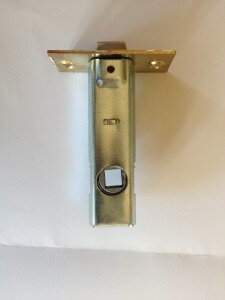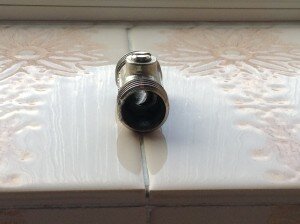OCD and the ‘catch 22′
Piss Poor
This is literally a piss poor design of toilet in a very posh Canadian hotel in Banff.
It must surely be a ‘woman only’ toilet because when a typical man (me) contemplates the paper (if you know what I mean) a certain appendage dangles into the water.
I can only assume the high water level is designed to diminish any unpleasant splash back from big jobbies but the design leaves much to be desired from a male perspective .
.
Wallpapering — some tips from experience.
Wallpaper comes and goes in fashion.
Currently, it is common to find people wanting just a ‘feature wall’ papered usually in a dramatic pattern.
Bear in mind:
Traditional papers expand when pasted.
This means that any small bubbles or wrinkles will disappear as the paper dries and shrinks. But it can also mean that each length shrinks away from its neighbour leaving a tiny gap allowing the underlying wall to show. If the colour is dramatic and dark then these gaps will stand out like a sore thumb because the underlying wall is likely to be light in contrast.
Paste-the-wall papers are becoming popular for bold feature wall designs and can help in this regard because the lengths have no time to expand as they are offered onto the pasted wall. But these papers can remain quite stiff to work around intricate corners or detail so they are really only suited to plain feature walls in case you thought of doing a whole room.
Another draw back with paste-the-wall paper is papering onto a lining paper since the moisture content of the paste will cause the lining paper to bubble as the wall is pasted ..although the lining paper should dry back.
International Rescue in a Flap
A regular client of mine phoned with a problem.
She explained she had soot appearing in a disused fireplace and thought there might be a bird stuck in the chimney.
I said I was no expert to initiate a rescue but would pop round to try.
I had a cunning plan which I thought might work. Using my sweeps brush I would carefully push up the chimney to the stranded bird (which I was sure was a pigeon). The bird would be magically elevated to the top of the chimney like he was standing on top of a lift in a shaft where he could just fly away.
A marvellous plan except the chimney was not as I’d expected. Two chimneys from two rooms came up like an inverted Y, joined and then carried on vertically to the roof.
The stupid pigeon was right at the join.
If only he knew it, coming down the chimney into either fireplace would be easy but bird’s instinct said ‘go up’
If my plan was to work the brush had to approach the pigeon from an angle. He could then alight, the brush would then change angle and continue to the chimney pot whereupon a slightly sooty pigeon would fly off happily.
But there was a plan B. The brush might approach the pigeon from the side and dislodge him down the other side of the inverted Y into the other fire place.
Confident one or other plan would succeed I loaded the brush.
My client was terrified at the prospect of a sooty bird flying about in either room and asked if she could leave.
I said fine and she left saying she would be very glad to finally have the thing out of the chimney.
I said: ‘Hang on a minute what do you mean finally?’
She said that she thought the bird had been in there about four days and promptly left.
I was now thinking this poor pigeon is probably at death’s door from near starvation and the last thing he needs is to have a big black brush coming at him.
Anyway I decided to press on and pushing slowly so as not to startle the poor bird there was suddenly a great amount of flapping noise.
Plan A was not working so I hoped the bird might find an exit into the other fireplace was a good outcome. But the brush had other ideas and it kept jamming wanting to go neither up the chimney nor across. All the time there was this sort of tragic flapping.
I decided this was really not working and withdrew my brush with a fair bit of soot. I found my client and said the only hope would be with the RSPCA or someone like that but I figured they would have to break into the chimney from outside and then brick-up the holes they’d made afterwards. This was assuming the poor pigeon after his recent scare from my brush would even last long enough to be rescued.
Anyway I left my client without charging her to ponder what to do.
Evidently she chose to do nothing because she called my three days later to say the the pigeon had popped his clogs and fallen into the fireplace of the front room.
Damp
Getting rid of the moist air:
Easy way—ventilate or extract replacing the internal air with dryer air from elsewhere.
The usual causes of the moist air:
Don’t get trapped behind a door
Tubular latches are used on almost every door in the land but the average quality of this simple and low cost mechanism leaves much to be desired.
Central to their operation is the cylindrical barrel through which the square section handle spindle passes.
Via a simple crank, this allow the door handle or door knob, by turning the spindle, to withdraw the latch and open the door.
However, as you can see in the photo below, the square hole in this little cylinder comes very close to edge at all the four corners of the square. This little metal cylinder turning in the metal case of the latch soon wears because there is no lubrication. The cylinder then disintegrates when one of the corners of the square wears to the edge of the cylinder. When it fails, pieces drop inside the latch.
With nothing to crank back the latch and additionally with pieces of metal jammed inside to foul things up you will not be able to get the latch to work.
Either this will happen when the door is shut or else the door will be shut after the latch has broken resulting in a door that cannot be opened …even if you take a handle off.
I have had clients phone up in despair at not being able to get into a room, or airing cupboard, or in some instances having children trapped in bedrooms.
Exasperated and frantic parents have virtually destroyed the door, or frame, or both to release their trapped children.
What can you do?
1) Buy good quality latches.
It’s true they don’t make these how they used to. The latch part of the locks on my doors still work fine despite being fitted in 1937 but modern ones often don’t last much more than a couple of years
2) Oil the latch periodically
This is difficult to do as you have to take off a handle on one side or the other of the door to get at the culprit cylinder.
3) If a door latch fails you can try to operate (i.e. withdraw) it manually by inserting a sharp object like a knife between the door and the frame to prod at the latch to try and withdraw it.
4) If all else fails it will be easier to mend the door frame than replace or mend the door so attack the timber of the door frame near the ‘keep’ (the metal bit where the latch engages in the frame) to release the door.

Multi-socket
Having recently been to Burma (Myanmar) I was surprised by the plug sockets there which occasionally dished out electricity in between power cuts.
There is no standard and you will usually find a mix of sockets even within a single room to cope with whatever plug you have.
Better still they have sockets like this (I just had to buy one which cost me 70p) and it will accept just about any plug at all although I’m not sure it would cope well with a US appliance rated for only 110v.
But I guess if it fries your hair dryer then that’s your problem.

How to make a bad situation worse
______________________
I don’t have to think twice and will strongly suggest future clients shop anywhere but Bathstore
One more cross to bear
This is just opinion.
At one of my DIY lectures today I was shown and Ulti-Mate screw which is supposed to be an enhanced version of the traditional cross head screw. Packs come with their own drill driver bit, but as yet screwdrivers for these screws are not available.
The benefits appear to be:
1) the bit and screw socket are precision engineered which means you can put the screw onto the driver bit and it fits so snugly that it won’t fall off even when pointing the screw straight down ..although I can’t imagine this would still be the case when the driver bit has worn.
2) They have a self-countersinking shoulder although as I understand it these are having to be modified because the screws will not currently sit properly in the ready-made countersunk holes of many hinges.
There are other benefits but here is my take.
There are already two standards of Philips and Pozidriv which are not entirely interchangeable and are just different enough to be irritating at times …so do we really need a third standard however good it might be?
These new screws seem to have a square centre to the socket hole in the screw head which from my brief inspection and testing seemed to make an ordinary Pozidriv or Philips screwdriver not fully enter. This will obviously allow easy camming-out of the driver when it slips resulting also in damage to the screwhead socket hole so making it difficult for a damaged screw to be withdrawn (unscrewed).
Slightly embarrassing
In all my years I have never had an isolating ball valve fail — you just turn the little widget with a screwdriver and if the slot is across the flow then it’s off and in-line with the flow then it’s on.
The one shown below went to an electric shower which needed replacing. But as you can see after I dutifully turned it off it actually sheared inside (probably due to limescale build-up) so when I uncoupled the shower quite a lot of water spurted out. You live and learn.



Recent Comments